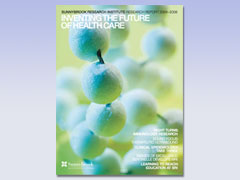Learning To Reach
Dr. Mira Puri, a scientist at Sunnybrook Research Institute (SRI), is passionate about education. "I think it's really important to have outreach to the public about science," she says. "In Canada, we need to be aware that the public's support is crucial. There's a gap between awareness of health issues and awareness of what scientists are doing."
Puri, who studies the cardiovascular and hematopoietic development of mammals, is working to narrow that gap. Several times a year she visits schools to educate children about what scientists do. She encourages her graduate students to do the same. She has also attended science fairs as a judge, where most kids appreciate having a real scientist evaluate their projects. Puri targets elementary schools because she has found that's where kids get most excited about science.
While primarily showcasing science as a potential career, Puri notes that those children and their parents may also be future donors to research funding agencies. "I think a lot of our issues in funding research fall back to what the public perceives as our productivity, and our utility in society. And that comes down to scientists going out and teaching the public," she says. "We shouldn't have an attitude of entitlement, and we should be accountable to the taxpayers who fund us."
To that end, Puri is encouraging other SRI scientists to participate in a program set up by the Canadian Institutes of Health Research. Called Synapse, it's a youth outreach fund for scientists and their trainees to give public talks, attend science competitions and provide mentored lab experiences for high-school students.
Other funding bodies have also discerned the importance of connecting scientists with students. For example, Ontario's Ministry of Research and Innovation has recognized the need for youth outreach by making it either the central or a mandatory component of several programs it runs, including the Youth and Science Technology Outreach Program and Early Researcher Award (ERA) Program. It recently awarded SRI scientist Dr. Jonathan Rast an ERA award. As part of his research program, Rast will visit grade 10 and 11 biology students in their classrooms to talk about his work on the sea urchin genome and run in-class experiments whereby the students will grow their own sea urchin embryos.
Rast, however, is not the only researcher involved in outreach at SRI. There are others, including Puri, each focusing on what he or she thinks will have the most impact.
Puri is positive about education within SRI. "There's a real sense of a peer group here. My students had a smooth transition to finding out who could help them with techniques they didn't know, and to meeting colleagues who encouraged them to think differently about their research." Sunnybrook's open lab structure, where researchers share space, facilitates the sharing of techniques and ideas, as do seminars, social events and retreats.
Scientists participate in these knowledge-sharing events and help trainees navigate the career aspects of the system, particularly proposal writing and the peer-review grant submission process. Puri involves her postdoctoral fellow in the review of other scientists' papers that have been submitted for publication to journals, thereby familiarizing her with the process she would engage in as a scientist and the scrutiny she can expect her papers to undergo.
Not all trainees, however, want to become scientists. Students, and technicians in particular, may want only advanced scientific knowledge, or to gain experience in a technique. Some will go on to work in industry. Puri says, "People are here for different reasons, and we have an obligation to teach them, to get them where they want to go, because we are an educational institution."
PDF / View full media release »





